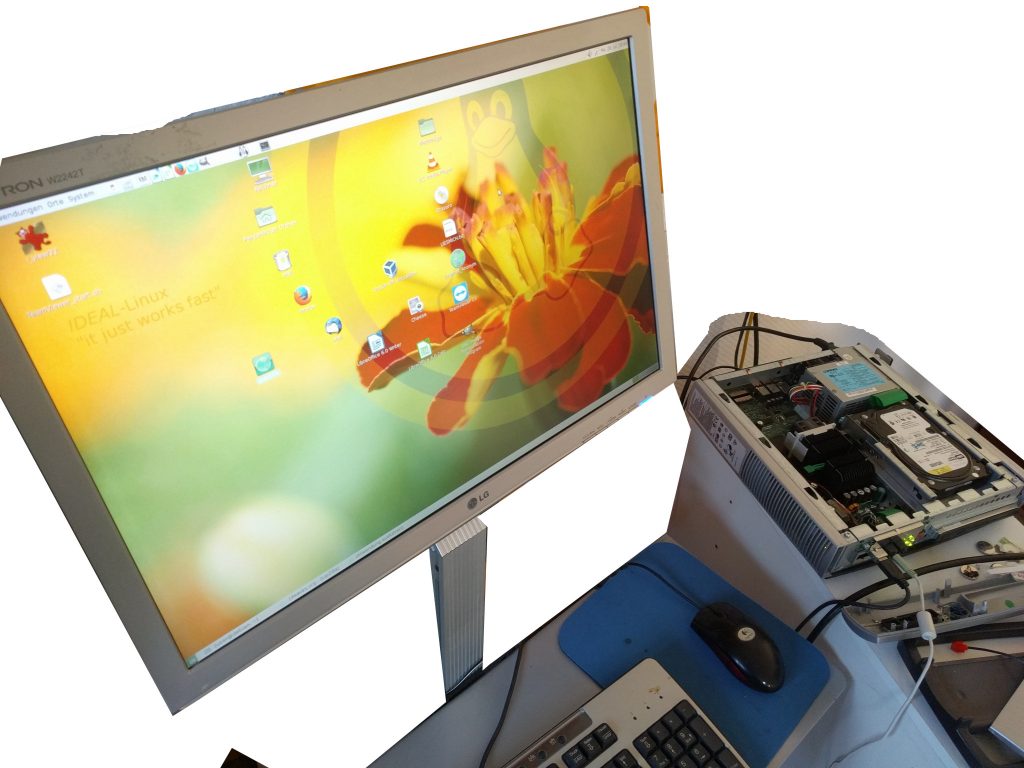today installed (1:1 copy with USB2IDE Adapter) Debian 8 32Bit aka ideal linux on Compaq “Evo D500”
and: IT JUST WORKS 🙂
works slow but it works (it is a Single Core Celeron, what do users expect?) X-D
512 MB RAM is not the problem also harddisk speed is okay, the CPU/maybe Chipset is the slow buddy on the team
======== DATE 2020-07-20 ======== lscpu Architecture: i686 CPU op-mode(s): 32-bit Byte Order: Little Endian CPU(s): 1 On-line CPU(s) list: 0 Thread(s) per core: 1 Core(s) per socket: 1 Socket(s): 1 Vendor ID: GenuineIntel CPU family: 6 Model: 11 Model name: Intel(R) Celeron(TM) CPU 1300MHz Stepping: 1 CPU MHz: 1296.102 BogoMIPS: 2592.20
full hardware specs Compaq Evo D500.txt generated by /scripts/hardware_detection.sh script
does it browse?
Firefox refuses to start because CPU has no SSE2 instruction set, but QupZilla browser works (Youtube ain’t working the CPU is too slow X-D)
“Falkon (formerly QupZilla[4]) is a free and open-source web browser. It is built on the Qt WebEngine[5][6] which is a wrapper for the Chromium browser core.[7]
As of July 2019, openMandriva uses Falkon as the default browser instead of Firefox.[3]”
src: https://en.wikipedia.org/wiki/Falkon#History
QupZilla is actually a pretty nice and resource efficient browser, that does some basic JavaScript 🙂
does it music?
yes! audio and VLC player work out of the box and the sound is decent 🙂
downloads:
users can download it here:
https://dwaves.de/downloads/ideal-linux-usbstick_32GByte_2019-06-16.img.gz
https://dwaves.de/downloads/ideal-linux-usbstick_32GByte_2019-06-16.img.gz.sha512sum.txt
- download
- unpack it
- then 1:1 copying image.img to harddisk or bootable usb stick
- run fsck on it: fsck -y -v -f /dev/sdaX
- then putting that harddisk into a computer should work too (make sure bios is set correctly to boot from it))
what user will need: an adapter IDE2USB to attach the (IDE in this case) harddisk directly to an already working GNU Linux PC:
# tested on hostnamectl Static hostname: giada Icon name: computer-desktop Chassis: desktop Operating System: Debian GNU/Linux 10 (buster) Kernel: Linux 4.19.0-8-amd64 Architecture: x86-64 # install pv (monitor progress) # and pigz (multi core gzip decompression) apt update; apt install pv pigz; # UNPLUG THE ADAPTER # analyse what harddisk are there lsblk -o 'NAME,MAJ:MIN,RM,SIZE,RO,FSTYPE,MOUNTPOINT,UUID' # PLUG IN THE ADAPTER # what harddisk was added? (that is most likely the target harddisk) lsblk -o 'NAME,MAJ:MIN,RM,SIZE,RO,FSTYPE,MOUNTPOINT,UUID' # write image to the usb attached harddisk pigz -dc /path/to/the/image/file/ideal-linux-usbstick_32GByte_2019-06-16.img.gz | pv | dd bs=1M of=/dev/sdX; # script it if one wants vim /scripts/make_linux_ideal_stick.sh #!/bin/bash if [ -z "$1" ] then echo "please pass device like this: /dev/sdb TARGET THE WHOLE DEVICE (sdb) NOT A PARTITION! (sdb1)" else echo "========== creating stick with device "$1 umount $1*; pigz -dc /path/to/the/image/file/ideal-linux-usbstick_32GByte_2019-06-16.img.gz | pv | dd bs=1M of=$1; # write image to usb stick # gunzip -c /path/to/the/image/file/ideal-linux-usbstick_32GByte_2019-06-16.img.gz | pv | dd of=$1; # write image to usb stick sync; fi
NICE WORK! ALL INVOLVED 🙂
a nice example, that even very old hardware is still useful, resources and the planet saved a bit more!
what could be improved?
yes more more lightweight desktops such as LXDE would have used less resources than MATE Gnome2,
but MATE Gnome2 is actually not that resource hungry either
it is really the CPU that is causing the holdup X-D
and the BIOS that counts every bit of RAM during startup X-D (takes ages X-D)
Links:
liked this article?
- only together we can create a truly free world
- plz support dwaves to keep it up & running!
- (yes the info on the internet is (mostly) free but beer is still not free (still have to work on that))
- really really hate advertisement
- contribute: whenever a solution was found, blog about it for others to find!
- talk about, recommend & link to this blog and articles
- thanks to all who contribute!




